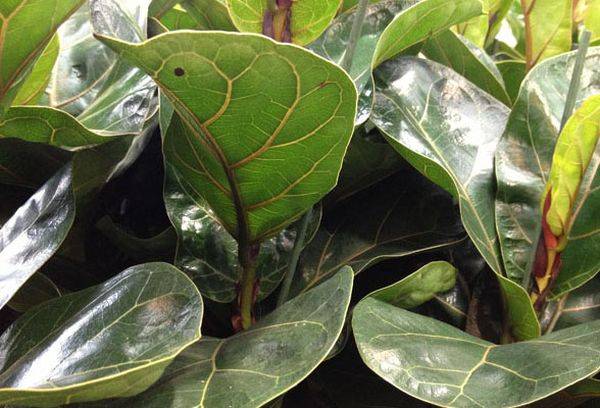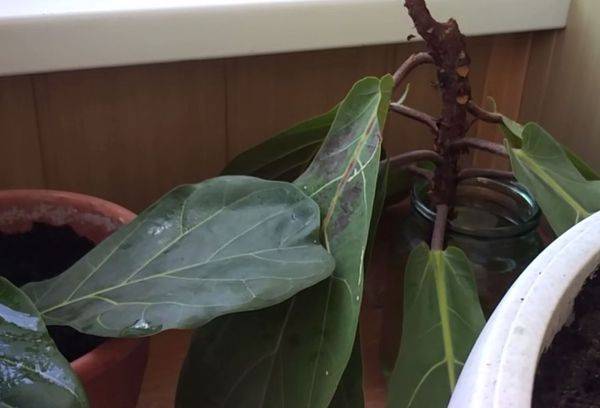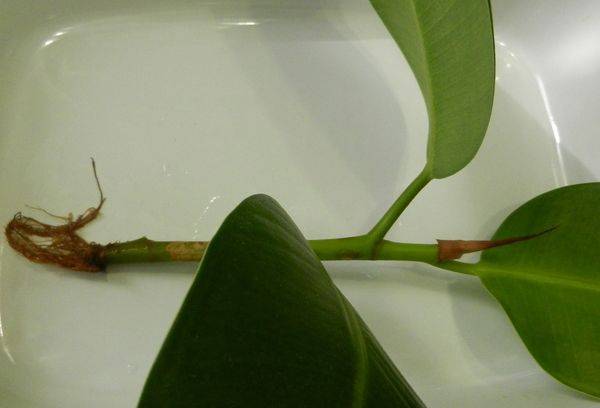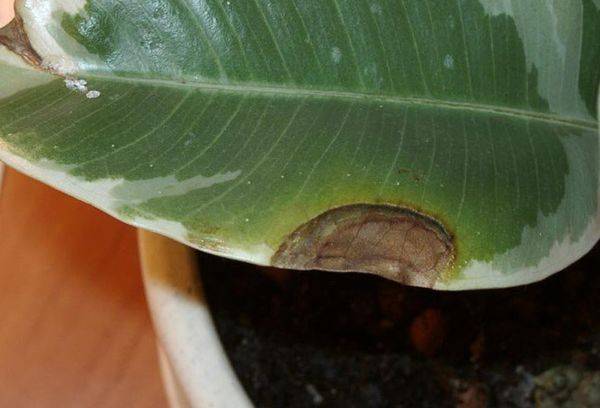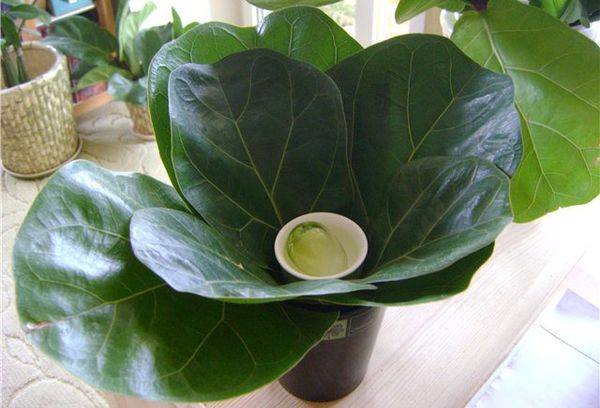Ficus lyreformis - a favorite of gardeners
Many gardeners love fairly large types of indoor plants - they become a worthy decoration for a home, office or greenhouse. Ficus lyreata is an excellent representative of evergreen trees suitable for growing indoors. He will grow quite large if you give him space and know what kind of care he needs.
Peculiarities
Ficus lurata - this is the name of the ficus lyreta in Latin - has an interesting character. He loves freedom and independence very much. It is best to place it away from other plants. It belongs to the mulberry family, but even with ficuses it does not go particularly well together.
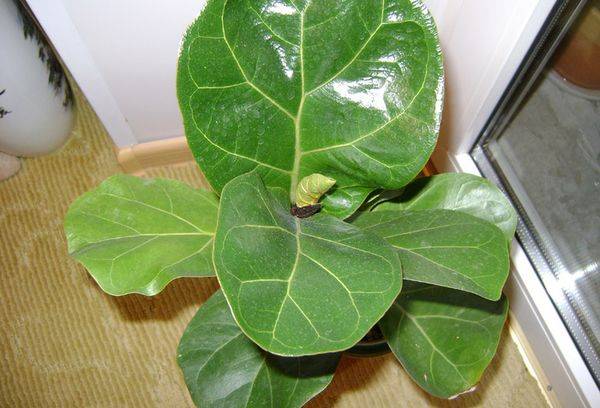
The tree got its name from the shape of its leaves: they resemble a violin, guitar, or lyre. They are the main advantage and decoration of the tree. Tough, on long petioles, rich green in color, with raised veins of a lighter tone, glossy and with a wavy brown. They look very impressive and are not nearly as heavy as, say, rubber ficus.
Lyre-shaped ficus is one of the most popular of its kind and is rightfully considered the pearl of the floriculture collection. It feels quite comfortable in a tub placed in an office or hallway, as well as in open ground in a garden or greenhouse. Under ideal conditions, the tree grows up to 5 meters in height. However, there is also a dwarf variety.
Another feature, in addition to the exquisite leaf blades, is the signs of an epiphytic plant: the lyre-shaped ficus needs support for normal development.
Interesting fact
In its homeland, in the forests of Africa, the lyre-shaped ficus often grows in the crown of another tree, clinging to it with aerial roots. Gradually, the roots reach the soil, entwining the trunk of their larger “neighbor”.
To grow at home, you can choose one of these plants:
- Phyllis Craig with a small crown and large beautiful leaves that reach 35 centimeters in length;
- Compacta and Bambino are varieties for lovers of compact ficuses; they have dense crowns, but the leaves are usually 10 centimeters smaller.
In general, when choosing a ficus lyreate, you must take into account that it is quite demanding. Conditions of detention should be as close to natural as possible. He loves light and moisture.
Rules of care and illness
First of all, you should think about lighting. Many gardeners actively rearrange their ficus throughout the year, and there is a justification for this. From April to September, the tree needs diffused rays; they should not dry out or burn the leaves. Thus, it is permissible to place the tub under the sun only in the evening. It is most convenient to place the flower in a room whose windows face north. From October to March, on the contrary, it is advisable to give the ficus maximum light. The tree is moved to the south window so that it absorbs every ray.
The second important factor is temperature - it should be high enough all year round. The plant will not survive on a balcony or unheated veranda. During the day it must be about 25 degrees, and at night not lower than 16.Sometimes the flower can withstand 12°C, but only if the cold is short-lived.
Advice
Many people make a serious mistake and constantly keep the ficus warm. In fact, large leaves will develop only if there are temperature changes. In summer, the ideal place would be a balcony or veranda. On hot days, you can even place the plant outside.
Before planting a plant, be sure to prepare the soil. To do this, take 3 parts of turf soil and 1 part peat and add the same amount of coarse sand. The soil must be sterilized so that it does not harbor pests and fungal pathogens.
After planting, the ficus needs to be watered regularly. However, the main mistake is excessive humidity. The roots should dry out. Tap water is rarely suitable for irrigation due to the large amount of chlorine, but it is allowed to leave tap water in bottles for about a day and then use it for ficus. In addition to watering periodically, at least once a month, it is advisable to give the plant a shower. The leaves are also regularly wiped: under a layer of dust they do not receive enough sunlight.
Important!
In winter, showering is contraindicated. The leaves should not be wet, maximum damp.
The lyre-shaped ficus, like all its closest brothers, loves high air humidity, up to 70%. Therefore, it will be a good habit to regularly spray the crown or place an aquarium, wet pebbles or moss nearby.
The most difficult moment is replanting the ficus. It is carried out at the end of spring, when active growth begins. In winter, the flower stagnates. During transplantation, it is necessary to treat the roots: all wrapped ones are completely cut off.Usually the roots grow straight down, but if there is not enough space, they begin to go up. All side ones are also allowed to be trimmed. You need to choose a pot that is tall and large enough: the root system of the lyre-shaped ficus develops well. Young plants are moved once a year, adults - once every few years.
Fertilizer is applied from March to September; it is better to avoid fertilizing in winter. Leaves should be protected from excess chemicals: if the solution accidentally gets on the leaf plate, it should be wiped with clean water.
Crown formation and reproduction
Crown formation largely occurs naturally. The number of leaves and their shape are affected by the intensity and direction of the sun's rays. That is why, in order to get an ideal spreading tree, it is best to rotate the ficus 90 degrees every week. Otherwise, the large leaves of the plant will shade part of the crown, and with a high probability the plant will become asymmetrical. This is the basic principle of the formation of the lyre-shaped ficus. Pruning is carried out only when it is necessary to reduce the height of an overgrown tree: in the spring the crown is cut off above the internode. The resulting cutting can be rooted.
Ficus propagation is done by cuttings. Some use the root system, but this complicates the process: it will be necessary to wait too long for the cutting to take root.
You need to choose a growing young stem (if it is completely woody, it will no longer take root).
- All leaves should be removed from it, leaving only one bud for development.
- A longitudinal cut is made and wrapped in moss.
- When aerial roots appear, the shoot is cut off and placed in water.
- When the roots become stronger, the seedling is ready to move into the ground.
Interesting fact
Why trim leaves? The future seedling is exposed to make it easier for it to take nutrients from the ground and not waste vitality on large leaves.
You definitely need to keep an eye on your new plant. Improper care causes problems, including pests and diseases. The former are easily defeated with the help of chemicals. The main difficulty is that you cannot treat the leaves, and aphids or mites can always hide. However, there are some drugs that are very gentle. The easiest way is to check the reaction during the day on one of the leaves.
Ficus diseases are very diverse. First of all, it is necessary to identify and analyze the symptoms, and only then begin treatment.
- The leaves are turning brown.
Such a change in shade means an excess of sun. Improper watering can also play an additional role. Direct rays are strictly contraindicated, and this must be remembered.
- Leaves are falling.
In this case, the sun is blocked by other leaves or there is simply not enough light. Also, lack of water often manifests itself with the same symptoms.
- Stop development.
Ficus does not grow only in winter. If stagnation is observed in the summer, then the cause is disease. This is a lack of nutrition or water. Feeding should be done a couple of times a month, at least.
Fungus also develops quite often. The main problem is insufficient hygiene. If the water stagnates in the pot or the leaves are too wet and dirty, then the risk of fungus is high. It is necessary to regularly inspect the ficus, especially the most inaccessible places.
This plant is quite demanding. During transplantation or processing, you should use only sterile instruments.
Why get a ficus?
Ficus lyreate is liked by most gardeners. It can stand in any chosen place, delighting guests and apartment owners with the lush greenery of its leaves at any time of the year. At home, it is often placed in the living room, bringing a touch of southern flavor to the interior. If you have your own plot, then in the summer a tub of ficus can decorate a gazebo, veranda or other open spaces.
Often these flowers become a decoration for indoor public spaces, because they grow really large and look beautiful.
An additional benefit of Ficus lyreata is that it is a true natural air purifier. Everyone knows about the benefits of house plants, because they saturate the room with oxygen. Ficus is ideal for such purposes: the huge leaves and large size of the entire tree allow you to feel the difference. It will be much more pleasant to be in a room with a ficus.
When caring for such a plant, it should be borne in mind that it is quite demanding. We will have to try to create conditions as close to natural as possible. You also need to remember that transplantation and other manipulations must be done carefully. Experienced gardeners note that the most important thing is to take into account the attitude of the ficus to chemicals. Only the most delicate ones are suitable, otherwise it is easy to ruin the plant.
Ficus lyreata has a chance to please literally everyone. At home it sometimes blooms, but the buds are too inconspicuous. The main advantage of this tree is its leaves, and they are equally beautiful at any time of the year.
